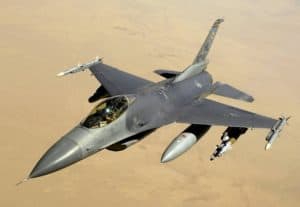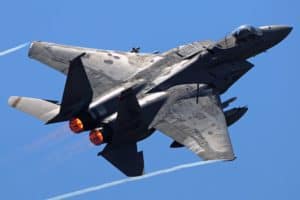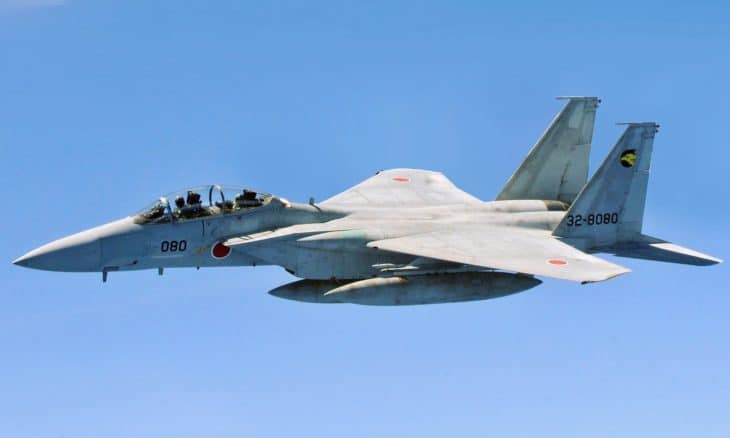The F-16 and the F-15 are both fighter jets used by the United States military. They are both incredibly advanced pieces of machinery and have both been responsible for many victories in battle. So, which is the better jet?
| Aircraft: | Lockheed Martin F-16 Fighting Falcon | McDonnell Douglas F-15 Eagle |
|---|---|---|
| Photo: |
 |
 |
| Country: | United States | United States |
| Manufactured: | from: 1978 to: Present | from: 1972 to: Present |
| ICAO: | - | F15 |
| Price: | $18 million | $29.9 million |
| Avionics: | Lockheed Martin Tactical Aircraft Systems | F15 HUD, APG-63 and 70 pulse-Doppler radar |
| Engine: | 1 × Pratt & Whitney F100-PW-220 | 2x Pratt & Whitney F100-PW-220 |
| Engine Type: | - | Turbofan |
| Power: | 29,160 pound-force | 23,770 pound-force |
| Max Cruise Speed: |
1147 knots 2,124 Km/h |
1630 knots 3,019 Km/h |
| Approach Speed (Vref): | - | 250 knots |
| Travel Range: |
2,280 Nautical Miles
4,223 Kilometers |
3,000 Nautical Miles
5,556 Kilometers |
| Fuel Economy: | - | - |
| Service Ceiling: | 50,000 feet | 65,000 feet |
| Rate of Climb: |
50000 feet / minute 254.00metre / second |
50000 feet / minute 254.00metre / second |
| Take Off Distance: |
345 metre 1,131.88 feet |
275 metre 902.22 feet |
| Landing Distance: |
457 metre 1,499.33 feet |
1100 metre 3,608.88 feet |
| Max Take Off Weight: |
19,187 Kg 42,300 lbs |
30,844 Kg 67,999 lbs |
| Max Landing Weight: | - |
20,185 Kg 44,500 lbs |
| Max Payload: |
7,167 Kg 15,800 lbs |
10,659 Kg 23,499 lbs |
| Fuel Tank Capacity: |
845 gallon 3,199 litre |
4,345 gallon 16,448 litre |
| Baggage Volume: | - | - |
| Seats - Economy: | 1 seats | 1 seats |
| Seats - Business Class: | - | - |
| Seats - First Class: | - | - |
| Cabin Height: | - | - |
| Cabin Width: | - | - |
| Cabin Length: | - | - |
| Exterior Length: |
15.06 metre 49.41 feet |
19.43 metre 63.75 feet |
| Tail Height: | - | 5.64 metre - 18.50 feet |
| Fuselage Diameter: | - | - |
| Wing Span / Rotor Diameter: |
9.96 metre 32.68 feet |
13.06 metre 42.85 feet |
| Wing Tips: | No Winglets | No Winglets |
| More Info: | Lockheed Martin F-16 Fighting Falcon | McDonnell Douglas F-15 Eagle |
|
Data presented is for entertainment purposes and should not be used operationally.
|
Other Lockheed Martin F-16 Fighting Falcon comparisons:
- Su-27 vs F-16
- F-35 vs F-16
- F-16 vs F-18
- F-22 Raptor vs F-16 Fighting Falcon
- Eurofighter Typhoon vs F-16 Fighting Falcon
Other McDonnell Douglas F-15 Eagle comparisons:
F-16 Fighting Falcon

The Lockheed Martin F-16 Fighting Falcon was developed and built for the United States Air Force to create a versatile aircraft that could be used in multiple roles. The F-16 was designed to be a multirole fighter, meaning it could be used for air-to-air and air-to-ground combat. The aircraft was also intended to be highly maneuverable, making it difficult for enemy pilots to target.
In addition, the F16 was equipped with advanced avionics and weapons systems, making it a formidable opponent in any aerial confrontation. The F16 has served the Air Force well over the years and remains one of the most capable aircraft in its fleet.
Thanks to its versatility and combat performance, the F16 will likely remain a vital part of the Air Force’s operations for many years.
F-15 Eagle

The McDonnell Douglas F-15 Eagle was designed in the early 1970s as an air superiority fighter. It first flew in July 1972 and entered service in 1976. The F15 has been exported to several countries and has seen action in several conflicts, including the Gulf War and Operation Iraqi Freedom.
The aircraft is powered by two turbofan engines capable of the supercruise, meaning it can fly at supersonic speeds without using afterburners.
The F15 has a large wing area and can carry a heavy payload of missiles and bombs. It also has an advanced avionics suite with a head-up display, radar, and helmet-mounted sight. The F15 has been continuously upgraded throughout its service life, and new versions are still being developed.
Differences between the F-16 & F-15
Regarding fighter jets, the F-16 and F-15 are two of the most popular options. But what are the key differences between these two aircraft? For starters, the F-16 is smaller and more agile than the F-15.
It also has a lower wing loading, which gives it better maneuverability. Additionally, the F-16 has a more powerful engine, which allows it to reach higher speeds. In terms of armament, the F-16 can carry more missiles than the F-15.
It also has a higher rate of fire for its cannons. And, thanks to its smaller size, the F-16 can carry more fuel and stay in the air longer than the F-15. Finally, there’s the price tag. The F-16 is less expensive to purchase and operate than the F-15. So, if you’re looking for a budget-friendly option, the F-16 is your best bet.
Similarities between the F-16 & F-15
Regarding military aircraft, the F-16 and F-15 are two of the most popular choices. Both are highly versatile and can be used in various roles, from air-to-air combat to air-to-ground strikes. But what are the main similarities between these two iconic planes?
The F-16 and F-15 have a similar design, with a single engine mounted in the middle of the fuselage.
Both planes are also equipped with advanced avionics and weapon systems, making them highly effective in combat. However, the F-16 is smaller and lighter than the F-15, making it more agile and maneuverable. It also has a lower wing loading, meaning it can take off and land at shorter runways.
The F-15 is more powerful and has a more extended range, making it better suited for long-distance missions. It also has a higher wing loading, giving it excellent flight stability. Both the F-16 and F-15 are exceptional aircraft that have been used by militaries all over the world. While they share some similarities, each plane has unique strengths that make it ideal for specific missions.
What’s better about the F-16?
The F-16 is one of the most famous fighter jets in the world, and it’s no wonder why. Here are four things that make the F-16 a cut above the rest:
- Incredibly maneuverable: The F-16 was designed to be highly maneuverable and definitely lives up to that reputation. It can perform tight turns and rapid changes in direction, making it a formidable opponent in air-to-air combat.
- Long range: The F-16 can fly hundreds of miles without refueling, meaning it can reach any target within its range.
- Heavily armed: The F-16 can carry missiles, bombs, and other weapons, making it a versatile war machine.
- Affordable: The F-16 is relatively affordable compared to other fighter jets, making it a popular choice for militaries worldwide.
What’s better about the F-15?
The F-15 is one of the most advanced fighter jets in the world. Here are four things that make it better than other jets:
- It’s fast: The F-15 is fast. It can reach speeds up to Mach 2.5, or about 1,500 mph. That’s fast enough to outrun a speeding bullet.
- Extremely maneuverable: The F-15 is maneuverable. It can perform rolls, loops, and other acrobatic maneuvers that other jets can’t match.
- Powerful engines: The F-15 has powerful engines. They produce more thrust than any other jet engine in the world, giving the F-15 incredible acceleration and speed.
- Long range: The F-15 has a long range. It can fly more than 1,700 miles without refueling, making it ideal for long-distance missions.
The F-15 is truly a superior jet fighter. It’s fast, maneuverable, and packed with powerful technology that makes it the best.
Conclusion
Overall, the F-16 and F-15 are incredible fighter jets that have seen plenty of action in combat. Whether you’re looking for speed, maneuverability, or heavy armament, there’s an aircraft out there to suit your needs.
But if you want a highly versatile jet with impressive speed and maneuverability, the F-16 is your best bet. So which is the better fighter jet: the F-16 or the F-15? That depends on what you’re looking for in a military aircraft. But overall, it’s safe to say that both planes are top contenders in the world of military aviation.


